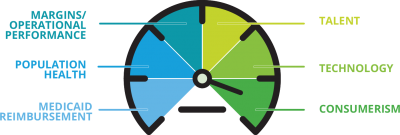| to find out how BHM helps payers and providers |
CEOs at hospitals and health systems are faced with increasing headwinds as they look to move forward in an uncertain environment. So what are the key issues and trends CEOs are facing? Deloitte interviewed 20 health system CEOs this year to find out. While none of the key themes emerging from our interviews have really changed since Deloitte last spoke with health system CEOs, the urgency certainly has. Instead of thinking about these issues in a futuristic sense, CEOs are ready to address and tackle them now.
For full 30 page report, click HERE.
Health System CEOs Identify Urgent Trends
 Turnover among hospital and health system chief executive officers (CEOs) is higher than in other industries. Along with navigating ever-changing policies and regulations, hospital CEOs must work with multiple payers, meet community obligations, stay current with evolving technology, contend with complex staffing issues, and keep their doctors and board members happy—all while delivering high-quality care.
Turnover among hospital and health system chief executive officers (CEOs) is higher than in other industries. Along with navigating ever-changing policies and regulations, hospital CEOs must work with multiple payers, meet community obligations, stay current with evolving technology, contend with complex staffing issues, and keep their doctors and board members happy—all while delivering high-quality care.
As a follow-up to previous interviews Deloitte Center for Health Solutions survey of US health system CEOs, Deloitte found that, of all the issues that may keep hospital CEOs up at night, they say they are most concerned about the future of Medicaid; CEOs also worry that the transition to value-based care is moving too slowly.
Declining margins is another top concern, as are challenges in finding, recruiting, and retaining forward-thinking and adaptable health care leaders. Keeping up with new technology—and the cybersecurity risks that accompany it—and adapting to evolving consumer expectations are also important issues. (Many of these issues are interrelated.) CEOs note that effectively addressing the above challenges is compounded by uncertainty about the new administration and its health care policies.
This Deloitte Center for Health Solutions series explores hospital CEOs’ top concerns, including:
- Preparing for potentially changing Medicaid reimbursement models and other policy issues
- Implementing population health and value-based care
- Maintaining or improving margins
- Recruiting and retaining top talent, including health care leaders
- Keeping up with evolving technology and cybersecurity risks
- Adapting to changing consumer demands and expectations
to find out how BHM helps payers and providers





